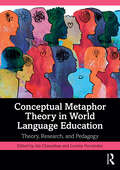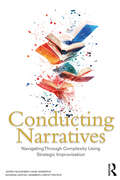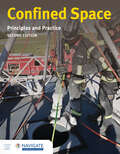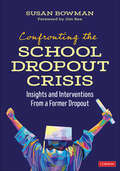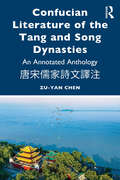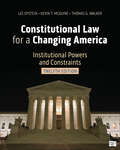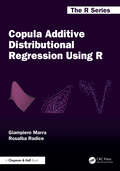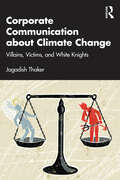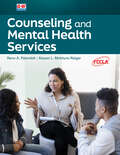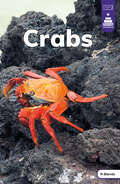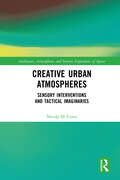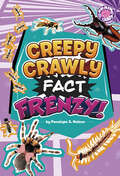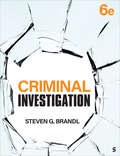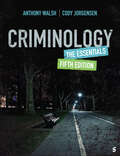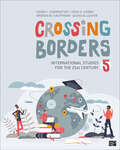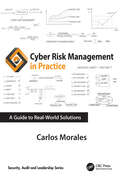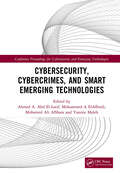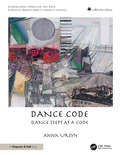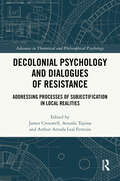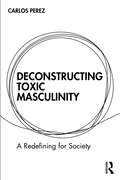- Table View
- List View
Conceptual Metaphor Theory in World Language Education: Theory, Research, and Pedagogy
by Loretta FernándezThis edited collection explores the scholarly and pedagogical implementations of Conceptual Metaphor Theory (CMT) in world language education. The chapters offer a diverse range of theoretical and pedagogical perspectives as well as methodologies aiming to achieve the following objectives: Introduce novice linguists, novice researchers, and pre-service language teachers to CMT, its extensions, and its applications, while providing an overview of the current state of the discipline; Shed light on new research and pedagogical practices for linguists, researchers, and language educators at all levels; Present theoretically founded and research-based examples of the pedagogical application of CMT across multiple world languages, including English, French, Mandarin, and Spanish; Highlight the experiences and perspectives of practitioner educators who have implemented CMT in world language education. By addressing these objectives, the book aims to provide a comprehensive and insightful exploration of CMT’s role in world language education, offering guidance and inspiration for both researchers and practitioners in the field.
Conducting Narratives: Navigating Through Complexity Using Strategic Improvisation
by Jesper Falkheimer Hans Gennerud Katarina Gentzel Sandberg Mats TyrstrupHow can the strategic direction for an organization be supported and communicated if planning, and even strategies, are no longer sufficient options in the age of complexity? In this book it is argued that sense-making communication defines contemporary societies and organizations in a world where narratives and the ability to engage in strategic improvisation are crucial. In the book, new and old ideas about communication and management are integrated into a framework rooted in the humanities and fine arts. The result is a new conceptual mindset for management which claims that jazz music, narrative theory, and improvisational theatre have more to offer to the development of organizations than traditional managerial models.
Confined Spaces 2E: Principles and Practice
by Jones & Bartlett LearningThe Public Safety Group, a Jones & Bartlett Learning brand, is pleased to present the second edition of Confined Space: Principles and Practice. This edition provides a complete confined space rescue training solution that meets and exceeds the intent of the job performance requirements (JPRs) within Chapter 7: Confined Space Rescue of the 2021 edition of NFPA 1006, Standard for Technical Rescue Personnel Professional Qualifications. First responders learn everything from sizing up and controlling an incident site to effective victim rescue and retrieval-all while keeping themselves, their colleagues, and the public safe. Engaging training components for each chapter include a You are the Rescuer case study, safety tips, skill drills, key terms, a chapter summary, and much more.Now in the second edition:New: Content is new and fully updated, and each knowledge objective and skills objective is based on and mapped to a section of NFPA 1006. New: The book is divided into sections for the three levels of responder training: Awareness (Chapters 1-4), Operations (Chapters 5-9), and Technician (Chapters 10-12). Each contains information specific to its respective level of training and skills. New: "On Scene" sections in each chapter are based on real events and include questions that immediately follow the narrative.New: All photography for Skill Drills is new.New: Review Questions for each chapter help ensure learner success.New: "You Are the Rescuer" features and discussion questions are included at the beginning of each section.New: Photographs and other visuals show up-to-date gear, techniques, and safety precautions.New: Up-to-date content showcases current equipment and best practices.Confined Space: Principles and Practice, Second Edition includes the following features: A single, complete curriculum solution that supports both students and instructorsOne access code that unlocks digital components to complement the print resource Study tools to help students succeed, including lecture outlines and flashcardsAn eBook, Audiobook, and Skill Drill Slides to engage all students and enable learning on the go © 2026 | 500 pages
Confronting the School Dropout Crisis: Insights and Interventions From a Former Dropout
by Susan BowmanReach out before they drop out Student dropout rates continue to soar, despite decades of funding, research, programs, and professional development initiatives. This is a wakeup call. Written by a former school dropout, Confronting the School Dropout Crisis encourages educators and related professionals to discover and explore the sometimes unnoticed reasons that youth drop out of school. With fresh strategies for prevention and intervention, this critical resource includes: How to reach and recover students who are at risk of dropping out or who already have Clear, impactful strategies that better engage and positively impact students who are at risk Moving personal stories from teens and the author Confronting the School Dropout Crisis invites you to rethink how you address real dropout issues with young people and how to incorporate fresh approaches to better reach and positively impact these students and their caregivers—before it’s too late.
Confronting the School Dropout Crisis: Insights and Interventions From a Former Dropout
by Susan BowmanReach out before they drop out Student dropout rates continue to soar, despite decades of funding, research, programs, and professional development initiatives. This is a wakeup call. Written by a former school dropout, Confronting the School Dropout Crisis encourages educators and related professionals to discover and explore the sometimes unnoticed reasons that youth drop out of school. With fresh strategies for prevention and intervention, this critical resource includes: How to reach and recover students who are at risk of dropping out or who already have Clear, impactful strategies that better engage and positively impact students who are at risk Moving personal stories from teens and the author Confronting the School Dropout Crisis invites you to rethink how you address real dropout issues with young people and how to incorporate fresh approaches to better reach and positively impact these students and their caregivers—before it’s too late.
Confucian Literature of the Tang and Song Dynasties: An Annotated Anthology 唐宋儒家詩文譯注
by Zu-yan ChenThis book establishes “Confucian Literature” as a multidisciplinary genre. By breaking down the barriers between literature and philosophy, this book opens the field of Chinese literature to new interpretive methods, and brings Confucian values to readers through literature. The anthology is a selection of 28 literary works—12 poems and 16 prose pieces—by 21 authors from the Tang and Song Dynasties (618–1279). The translations, arranged side by side with the original texts, strive to remain as faithful as possible to the wording of the source material, and conveying its meaning, style, and beauty. The commentary investigates philosophical discourse, locates Confucian values, and points to where literature joins philosophy.
Constitutional Law for a Changing America: Institutional Powers and Constraints (Constitutional Law for a Changing America)
by Kevin T. McGuire Lee J. Epstein Thomas G. WalkerIn Constitutional Law for a Changing America: Institutional Powers and Constraints, bestselling authors Lee Epstein, Kevin T. McGuire, and Thomas G. Walker show students how political factors influence judicial decisions and shape the development of constitutional law. The Twelfth Edition, updated with additional material such as recent court rulings, more than 500 supplemental cases, and greater coverage of executive, legislative, and judicial power, facilitates a deeper understanding of how the U.S. Constitution defines what institutions can and cannot do. This book is ideal for Constitutional Law courses in the two-semester sequence that covers powers and constraints. For courses that cover both rights and liberties and the separation of powers in one semester, see Constitutional Law for a Changing America: A Short Course.
Constitutional Law for a Changing America: Institutional Powers and Constraints (Constitutional Law for a Changing America)
by Kevin T. McGuire Lee J. Epstein Thomas G. WalkerIn Constitutional Law for a Changing America: Institutional Powers and Constraints, bestselling authors Lee Epstein, Kevin T. McGuire, and Thomas G. Walker show students how political factors influence judicial decisions and shape the development of constitutional law. The Twelfth Edition, updated with additional material such as recent court rulings, more than 500 supplemental cases, and greater coverage of executive, legislative, and judicial power, facilitates a deeper understanding of how the U.S. Constitution defines what institutions can and cannot do. This book is ideal for Constitutional Law courses in the two-semester sequence that covers powers and constraints. For courses that cover both rights and liberties and the separation of powers in one semester, see Constitutional Law for a Changing America: A Short Course.
Copula Additive Distributional Regression Using R (Chapman & Hall/CRC The R Series)
by Giampiero Marra Rosalba RadiceCopula additive distributional regression enables the joint modeling of multiple outcomes, an essential aspect of many real-world research problems. This book provides an accessible overview of this modeling approach, with a particular focus on its implementation in the GJRM R package, developed by the authors. The emphasis is on bivariate responses with empirical illustrations drawn from diverse fields such as health and medicine, epidemiology, economics and social sciences.Key Features: Provides a comprehensive overview of joint regression modeling for multiple outcomes, with a focus on bivariate responses Offers a practical approach with real-world examples from various fields Demonstrates the implementation of all the discussed models using the GJRM package in R Includes supplementary resources such as data accessible through the GJRM.data package in R and additional code available on the authors' webpages This book is designed for graduate students, researchers, practitioners and analysts who are interested in using copula additive distributional regression for the joint modeling of bivariate outcomes. The methodology is accessible to readers with a basic understanding of core statistics and probability, regression, copula modeling and R.
Corporate Communication about Climate Change: Villains, Victims, and White Knights
by Jagadish ThakerEmbedded in the emerging field of climate change communication, Thaker provides a comprehensive analysis of enablers and barriers to corporate action on climate change, business role and influence on media coverage of climate change, and its impact on public opinion and the policy-making process.Focusing on extensive academic research, business reports, case studies, and best practices from around the world, this book offers a practical guide to effective strategies in corporate climate change communication, including leadership communication, rebuilding public trust amidst greenwashing scandals, and engaging stakeholders with business action on climate change. The book provides new directions on the role of social media influencers, artificial intelligence, and big data in enhancing transparency in business actions and effective communication with key stakeholders.This book is an essential read for students, scholars, and professionals interested in the emerging fields of climate change communication, strategic communication, and related areas of sustainability and Environmental, Social, and Corporate Governance (ESG) communication.
Counseling and Mental Health Services
by Reno A. Palombit Alyson L. McIntyre-ReigerCounseling and Mental Health Services is a text designed specifically for high school students who are interested in exploring facets of mental health services, including related careers like psychology and counseling, social work, psychiatry, and life coaching. The text begins by addressing students’ understanding of mental health, before expanding outward to relationships with others, structures of the nervous system and neurodivergence, disorders and treatments, and counseling and mental health careers and career skills. With a focus on self-reflection, this text guides students to understand mental health concepts before moving on to relationships, brain science, and career skills.
Crabs
by Marley RichmondCrabs pinch and grip with strong claws. People may catch and cook crabs to eat! Beginning readers hone their phonics skills while learning all about crabs and where they live. As readers practice decoding words with r-blends, they gain science knowledge. Every Stairway Decodables nonfiction book combines multiple aspects of the Science of Reading to support small group instruction, independent reading, and reading practice at home.
Creative Urban Atmospheres: Sensory Interventions and Tactical Imaginaries (Ambiances, Atmospheres and Sensory Experiences of Spaces)
by Nicola Di CroceCreative Urban Atmospheres explores the potential for urban planners, researchers, and artists to intervene in the atmosphere of spectacle dominating current neoliberal urbanism strategies through sensory and sound-based artistic interventions drawing from Tactical Urbanism and Research-Creation. This book equips readers with tools and insights needed to address the pressing challenges of urban livability and inclusiveness in the face of neoliberal urbanism.Through engaging discussions and a case study conducted in Montreal’s Quartier des Spectacles, the book demonstrates how sound-based and sensory interventions can reshape urban atmospheres, fostering cohabitation and inclusiveness for diverse populations. Key features include an interdisciplinary emphasis on the intertwinements of academic research, artistic practice, and participatory community engagement, ensuring that readers gain both theoretical understanding and practical approaches. With its focus on innovative methods such as Research-Creation and socially engaged art, this book not only critiques existing urban strategies but also empowers planners, artists, and communities with tactics for collaboratively transforming underused urban spaces into vibrant, livable, and inclusive social environments.This book is designed for a diverse audience deeply invested in the future of urban spaces. It will be of interest to urban planners seeking innovative approaches to address urban polarization and promote inclusiveness, as well as academic researchers in urban studies and geography exploring the intersections of Tactical Urbanism and sensory interventions. Artists, designers, and architects will find inspiration in its emphasis on creative, participatory approaches while policymakers and community advocates can draw practical insights for fostering livable, inclusive cities. It also speaks to anyone with a vested interest in the challenges facing contemporary cities, including gentrification, touristification, and neoliberal urban pressures on the most marginalized groups.
Creepy Crawly Fact Frenzy!
by Penelope S. NelsonThere’s a CREEPY CRAWLY FACT FRENZY headed your way! Did you know the Goliath birdeater spider can grow to be a foot long? Or that a dragonfly can fly 20 miles per hour? Dozens of bite-size creepy crawly facts are paired with surprising bug photos, welcoming in even the most reluctant readers. Whether kids are in the mood to browse or to devour a book from cover to cover, even a dedicated fan of all things creepy crawly is sure to learn something surprising as they flip through these pages.
Criminal Investigation
by Steven G. BrandlCriminal Investigation, Sixth Edition offers a comprehensive and engaging examination of criminal investigation and the vital role criminal evidence plays in the process. Written in a straightforward manner, the text focuses on the five critical areas essential to understanding criminal investigations: background and contextual issues, criminal evidence, legal procedures, evidence collection procedures, and forensic science. In this brand new edition, author Steven G. Brandl goes beyond a simple how-to on investigative procedures, and draws from fascinating modern research, comprehensive cases, and criminal evidence to demonstrate their importance in the real world of criminal justice, providing students with practical insights into the field of criminal investigation.
Criminal Investigation
by Steven G. BrandlCriminal Investigation, Sixth Edition offers a comprehensive and engaging examination of criminal investigation and the vital role criminal evidence plays in the process. Written in a straightforward manner, the text focuses on the five critical areas essential to understanding criminal investigations: background and contextual issues, criminal evidence, legal procedures, evidence collection procedures, and forensic science. In this brand new edition, author Steven G. Brandl goes beyond a simple how-to on investigative procedures, and draws from fascinating modern research, comprehensive cases, and criminal evidence to demonstrate their importance in the real world of criminal justice, providing students with practical insights into the field of criminal investigation.
Criminology: The Essentials
by Anthony Walsh Cody JorgensenIn Criminology: The Essentials, authors Anthony Walsh and Cody Jorgensen introduce students to major theoretical perspectives and criminology topics in a concise, easy-to-read format. This straightforward overview of the major subject areas in criminology thoroughly covers the most up-to-date advances in theory and research, while challenging students to consider the applications of these theories as well as their policy implications. Updates to the Fifth Edition include new topics and developments in criminology, such as racial disparities in arrest rates, insights from the Big Five personality traits, cognitive behavioral therapy, gun violence and policy, and the opioid epidemic. It also offers detailed evaluations of theories to deepen student understanding and foster engaging classroom discussions.
Criminology: The Essentials
by Anthony Walsh Cody JorgensenIn Criminology: The Essentials, authors Anthony Walsh and Cody Jorgensen introduce students to major theoretical perspectives and criminology topics in a concise, easy-to-read format. This straightforward overview of the major subject areas in criminology thoroughly covers the most up-to-date advances in theory and research, while challenging students to consider the applications of these theories as well as their policy implications. Updates to the Fifth Edition include new topics and developments in criminology, such as racial disparities in arrest rates, insights from the Big Five personality traits, cognitive behavioral therapy, gun violence and policy, and the opioid epidemic. It also offers detailed evaluations of theories to deepen student understanding and foster engaging classroom discussions.
Crossing Borders: International Studies for the 21st Century
by Harry I. Chernotsky Heidi H. Hobbs Brenda M. Kauffman Sasha AllgayerCrossing Borders: International Studies for the 21st Century provides a framework to help students understand world issues, built upon an understanding of the many borders that define the international system. In the Fifth Edition, renowned authors Harry I. Chernotsky and Heidi H. Hobbs are joined by new coauthors Brenda M. Kauffman and Sasha Allgayer to address many of the different fields that constitute international studies—geography, politics, economics, sociology, and anthropology—and give instructors a starting point from which they can pursue their own disciplinary interests. In addition to developing a better understanding of the world, students also learn how to increase their own global engagement through study abroad, internships, and career options.
Crossing Borders: International Studies for the 21st Century
by Harry I. Chernotsky Heidi H. Hobbs Brenda M. Kauffman Sasha AllgayerCrossing Borders: International Studies for the 21st Century provides a framework to help students understand world issues, built upon an understanding of the many borders that define the international system. In the Fifth Edition, renowned authors Harry I. Chernotsky and Heidi H. Hobbs are joined by new coauthors Brenda M. Kauffman and Sasha Allgayer to address many of the different fields that constitute international studies—geography, politics, economics, sociology, and anthropology—and give instructors a starting point from which they can pursue their own disciplinary interests. In addition to developing a better understanding of the world, students also learn how to increase their own global engagement through study abroad, internships, and career options.
Cyber Risk Management in Practice: A Guide to Real-World Solutions (Security, Audit and Leadership Series)
by Carlos MoralesCyber Risk Management in Practice: A Guide to Real-World Solutions is your companion in the ever-changing landscape of cybersecurity. Whether you're expanding your knowledge or looking to sharpen your existing skills, this book demystifies the complexities of cyber risk management, offering clear, actionable strategies to enhance your organization's security posture. With a focus on real-world solutions, this guide balances practical application with foundational knowledge.Key Features: Foundational Insights: Explore fundamental concepts, frameworks, and required skills that form the backbone of a strong and pragmatic cyber risk management program tailored to your organization’s unique needs. It covers everything from basic principles and threat modeling to developing a security-first culture that drives change within your organization. You’ll also learn how to align cybersecurity practices with business objectives to ensure a solid approach to risk management. Practical Application: Follow a hands-on step-by-step implementation guide through the complete cyber risk management cycle, from business context analysis to developing and implementing effective treatment strategies. This book includes templates, checklists, and practical advice to execute your cyber risk management implementation, making complex processes manageable and straightforward. Real-world scenarios illustrate common pitfalls and effective solutions. Advanced Strategies: Go beyond the basics to achieve cyber resilience. Explore topics like third-party risk management, integrating cybersecurity with business continuity, and managing the risks of emerging technologies like AI and quantum computing. Learn how to build a proactive defense strategy that evolves with emerging threats and keeps your organization secure. “Cyber Risk Management in Practice: A Guide to Real-World Solutions by Carlos Morales serves as a beacon for professionals involved not only in IT or cybersecurity but across executive and operational roles within organizations. This book is an invaluable resource that I highly recommend for its practical insights and clear guidance” – José Antonio Fernández Carbajal. Executive Chairman and CEO of FEMSA
Cybersecurity, Cybercrimes, and Smart Emerging Technologies: Proceedings of the Second International Conference on Cybersecurity, Cybercrimes, and Smart Emerging Technologies (CCSET 2023), Riyadh, Saudi Arabia, 5th–7th December, 2023 (Conference Proceedings for Cybersecurity and Emerging Technologies)
by Yassine Maleh Abd El-Latif, Ahmed A. Mohammed A ElAffendi Mohamed Ali AlSharaThis book presents cutting-edge research and advancements in the rapidly evolving fields of cybersecurity, cybercrimes, and smart emerging technologies. It serves as a comprehensive reference guide for the latest trends and challenges in securing our digital world.It highlights critical themes such as the application of AI and machine learning in threat detection and automation, the security implications of blockchain and distributed ledger technologies, safeguarding critical infrastructure and the IoT, addressing data privacy and governance, and advancing malware analysis and detection techniques. It also delves into technological breakthroughs in deep learning for fake account detection, blockchain for secure data exchange, DDoS mitigation strategies, and novel approaches to malware analysis. These findings provide valuable insights into current and emerging cyber threats and effective countermeasures.This book is an essential resource for researchers, cybersecurity professionals, policymakers, and anyone seeking to understand the complex landscape of cybersecurity in the digital age.
Dance Code: Dance Steps As A Code
by Anna UrsynMany people relax when coding is introduced as a language, rather than math. Even if someone creates alone, the technology involved in the process has already been developed by somebody else. Even one person's business requires professional input from others, and collaborations are often performed online. This book mixes experiences in art, coding, music, dance, choreography, video, and stage design. Dances have unique structures and so do computer codes. In both disciplines, steps are applied following patterns, and are guided by rules and restrictions. The rules obey conditions. The Dance Code script aims to make coding less feared by readers when talking with coders on the job and typing better prompts when using artificial intelligence. In this book, a dramatized, choreographed story unfolds technical information about coding and dancing.The Dance Code script tells the story of an online interaction between a coder and a prima ballerina, resulting in a shared understanding of their respective fields. An exchange between a coder and a dancer may inspire new ways to look at visually presenting knowledge through dancing, performing, or choreographed movement. Hence, the audience learns without studying.It is a part of the “Knowledge Through the Arts” series, consisting of:Dance Code - Dance Steps as a CodeNew Storytelling - Learning Through MetaphorsCode Appreciation - Reshaping KnowledgeNature Appreciation - Knowledge as Art
Decolonial Psychology and Dialogues of Resistance: Addressing Processes of Subjectification in Local Realities (Advances in Theoretical and Philosophical Psychology)
by James Cresswell Atsushi Tajima Arthur Arruda Leal FerreiraInterweaving rich theory on dialogism, power, and resistance together with situated scenarios addressing the production of psychological knowledge, this book explores decoloniality as it interfaces with strategic fields in psychology.Current movements in global sentiment have raised important calls for decolonial action. In this volume an international set of authors come together to critically challenge power by considering how colonial mindsets develop and are retained. Drawing on dialogism inspired by Bakhtin, Vygotsky, and other leading thinkers of dialogicality, the book focuses on dialogue and how it is tied to the ability to think in ways outside colonial mindsets. It challenges approaches that run the risk of bypassing how fundamental colonialism has become for human thinking, and incorporates visions to consider how, both conceptually and methodologically, a postcolonial or decolonial psychology can be done. In so doing, it guides readers beyond the status quo to consider a program to improve psychology, formulate a new psychological culture, and bring about discussion beyond the permanent – yet generative – tension between liberating and subordinating psychologies.The book will be key reading for theoretical and critical psychology scholars and postgraduate students, particularly those interested in community engagement and decolonizing psychology. It will also be of interest to those engaged in research in Bakhtian studies, critical theory, and power studies.
Deconstructing Toxic Masculinity: A Redefining for Society
by Carlos PerezThis accessible book explores toxic masculinity, looking at how to define it, and how we can and should challenge its spread. This book draws on Derrida’s deconstruction, using the philosophical lens to deconstruct what toxic masculinity means and to better understand its significance for our society. It focuses on how harmful aspects of masculinity spread, infiltrate, and intoxicate our societies and how existing structures allow aspects of harmful masculinity to become toxic. This book also features discussions and analysis of participants’ lived experiences of masculinities, alongside the author’s reflections. It explores the relevance of toxic masculinity in work environments, politics, relationships, and gender roles and seeks to challenge and mitigate its damages for everyone. Encouraging critical thinking and understanding of healthier ways of being for all, this timely book will be of interest to therapists, counselors, teachers, and practitioners of family studies. It will also be useful reading for students in the fields of psychology, gender studies, sociology, and related fields.
